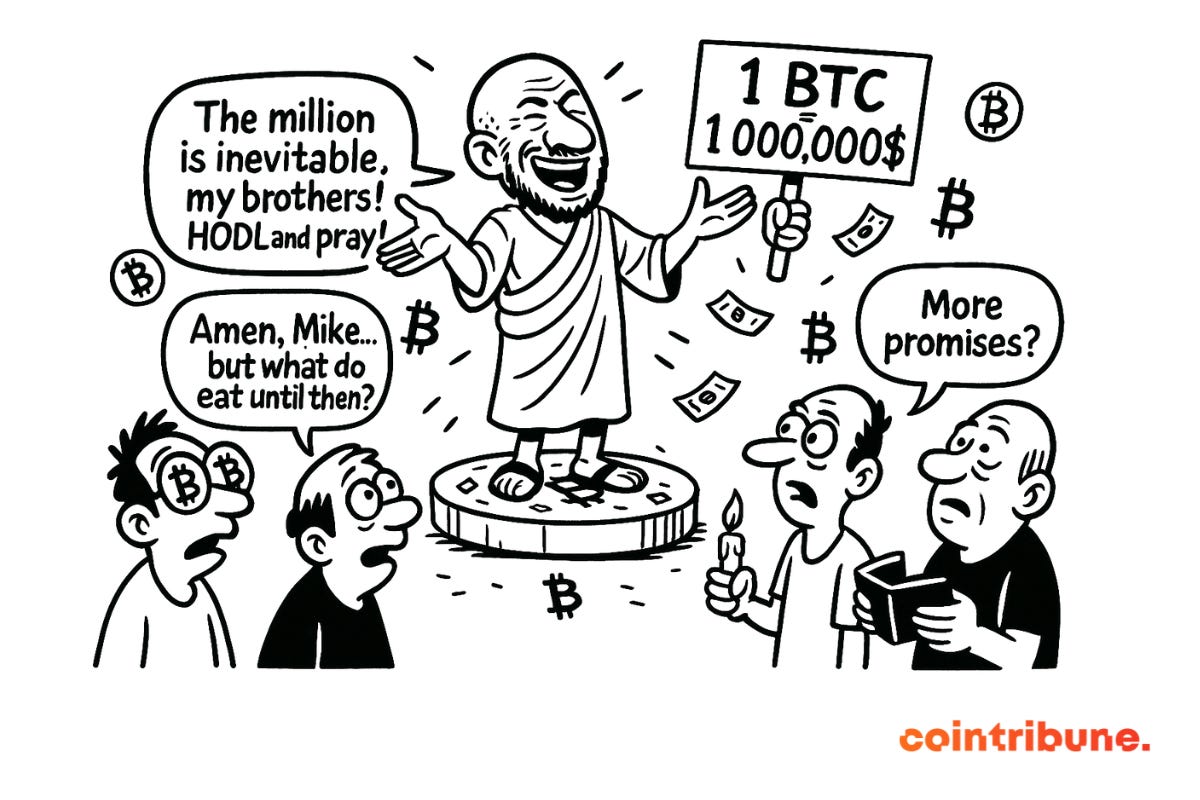💣Crypto: Over one billion dollars liquidated after Israel-Iran strikes
Welcome to the Saturday, June 14, 2025 Daily Tribune ☕️
Hello Cointribe! 🚀
Today is Saturday, June 14, 2025, and as every day from Tuesday to Saturday, we summarize the news from the last 24 hours that you should not miss!
But first…
✍️ Cartoon of the day:
A quick look at the market…
🌡️ Temperature:
🌤️ Partly sunny
24h crypto recap! ⏱
🌪️ Over one billion dollars liquidated after Israeli strikes on Iran
Crypto markets suffered $1.16B in liquidated positions in less than 24 hours following Israeli strikes on Iran, with Bitcoin falling by 2.8% and Ethereum by 7.8%.
🏅 Mike Novogratz convinced: 1 million dollars for 1 Bitcoin
Mike Novogratz believes Bitcoin could reach $1,000,000, relying on its institutional adoption and its limited quantity of 21 million.
🛒 Shopify adopts USDC for global payments
Shopify integrates USDC via Shopify Payments on the Base network (Ethereum L2), in partnership with Coinbase, Stripe and Shop Pay, with no additional fees.
📉 The US Treasury bets on a stablecoin market worth $2 trillion
Scott Bessent, US Treasury Secretary, estimates that dollar-backed stablecoins could reach a market capitalization of $2 trillion by 2028.
Crypto of the day: Hyperliquid (HYPE)
🧠 Technology and innovation
Hyperliquid is a cross-chain liquidity protocol designed to become the reference infrastructure for universal liquidity trading. It aggregates liquidity pools from multiple blockchains, allowing users to transfer funds and trade instantly across networks without relying solely on traditional bridges. Thanks to a combination of interoperable smart contracts, sophisticated oracles, and a decentralized router, Hyperliquid offers a smooth, secure, and cost-effective experience for managing multi-chain assets.
The protocol simplifies trading operations by allowing any user or protocol to access a unified liquidity network, while maintaining security through a decentralized infrastructure validated by participating nodes.
💰 HYPE Token – Utility and distribution
The HYPE token serves several crucial purposes:
Governance: participation in decisions concerning protocol parameters and future innovations.
Staking: holders can lock their tokens to secure the system and benefit from rewards derived from protocol fees.
Incentives: distribution of tokens to liquidity providers to stimulate network growth.
The launch of HYPE was structured around a targeted distribution: a strategic pre-sale, an initial liquidity farming, and a share reserved for the community and DAO allocators, with vesting mechanisms to encourage long-term alignment.
📊 Market data (as of June 14, 2025)
Current price: approximately $41.80 USD
24-hour change: +4.62%
Market capitalization: between $13.9 and $14.1 billion USD
CoinMarketCap rank: #11
Circulating supply: approximately 334 million HYPE
24-hour trading volume: between $358 and $419 million USD
Pi Network facing the transparency test: technical crisis or structural deadlock?
Presented as a revolutionary project aiming to democratize crypto access via a mobile app, Pi Network finds itself today under fire. In a few months, the project has shifted from an enthusiastic community dynamic to a deep trust crisis.
KYC blocks, recurring bugs, lack of dApps, massive price drop and opacity in governance feed growing distrust.
Malfunctions and disappointments: the community on the verge of breaking
Since the launch of the mainnet, feedback has been alarming. Thousands of users report the inability to recover their tokens despite completing the KYC process. On forums, bitterness dominates: pioneers of the mobile network see their years of virtual mining remain without usable value.
The situation worsens due to the complete absence of an active ecosystem. No decentralized application, no DeFi mechanism, no concrete use case for the Pi currency — the network remains technically “alive,” but economically empty.
Moreover, uncertainty hangs over the real tokenomics: suspicions of pre-mining, unclear internal distributions, and sales suspected by team members fuel a toxic climate.
A high-risk positioning without clear infrastructure
The project still has not delivered what constitutes the basis of all trust in the crypto universe: the protocol source code remains closed. At a time when Ethereum, Solana or even TonCoin strengthen their open foundations, Pi Network maintains a centralized architecture. Result: opaque governance and lack of community consensus.
The drop of more than 70% of the token after launch, combined with a lack of a concrete roadmap on listings (Binance, Coinbase), seriously weakens the external credibility of the project. Even the announcement of a $100M Pi Ventures fund did not restore confidence: it was, on the contrary, interpreted as a diversion tool amid internal turmoil.
Pi Network is today at a critical crossroads of its existence. Either the team launches a strategy of radical transparency — opening the code, activating a real decentralized network, clarifying distribution rules and deploying dApps — or it risks fueling the growing perception of an unsustainable, even potentially opportunistic project.









